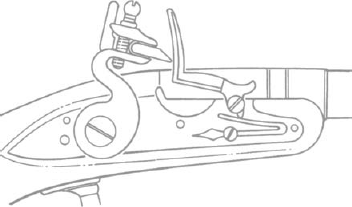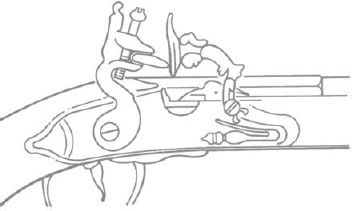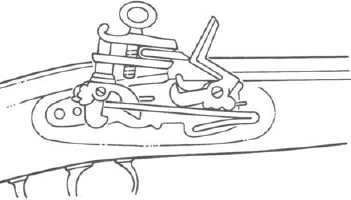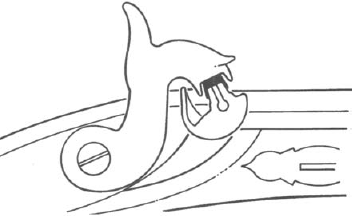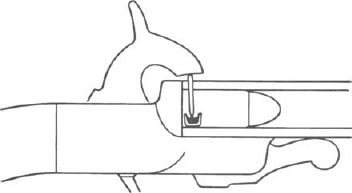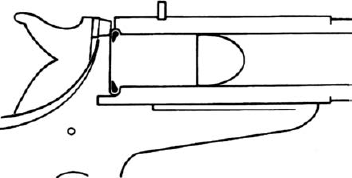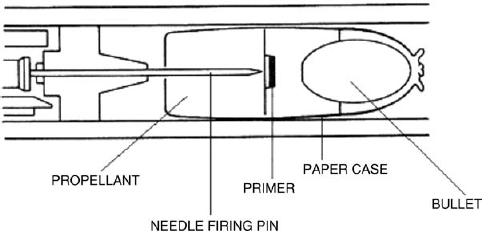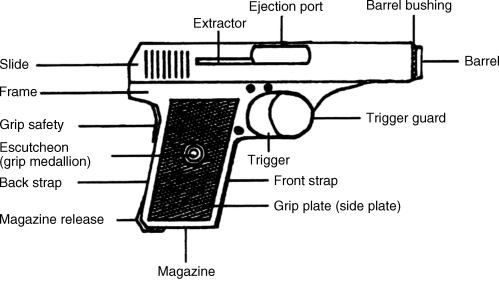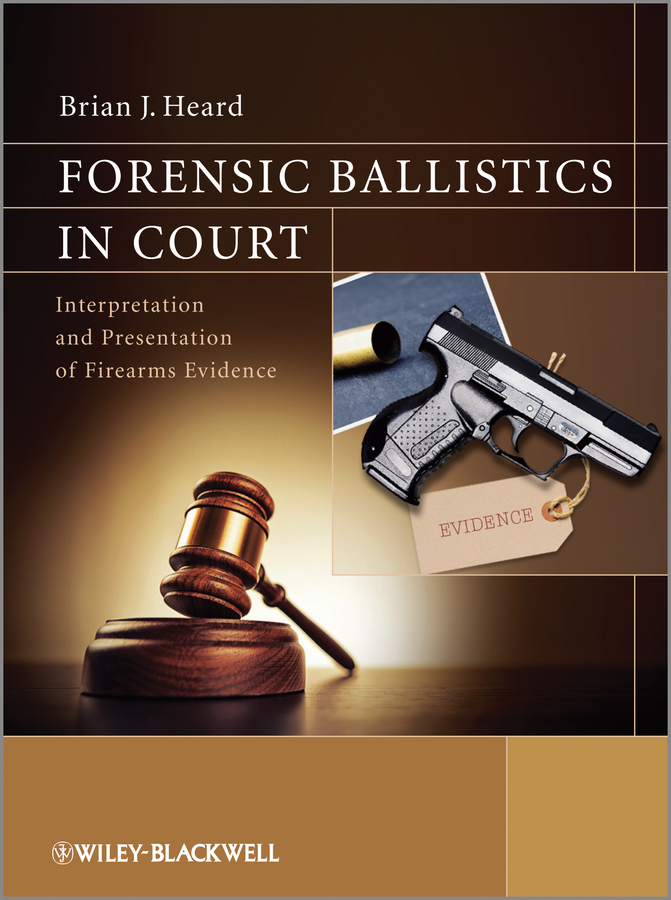
Contents
Cover
Title Page
Copyright
About the Author
Introduction
About the Companion Website
chapter 1: Firearms History
1.0.1 Introduction
1.0.2 The Flintlock (Figure 1.0.1)
1.0.3 The Percussion System (Figure 1.0.5)
1.0.4 The Pinfire System (Figure 1.0.6)
1.0.5 The Rimfire System (Figure 1.0.7)
1.0.6 The Dreyse Needle Fire System (Figure 1.0.8)
1.0.7 The Centre Fire System (Figure 1.0.9)
1.0.8 The Revolver (Figure 1.0.10)
1.0.9 The Self-Loading Pistol (Figure 1.0.11)
Further Reading
Chapter 2: Weapon Types and Their Operation
2.0.1 Introduction
2.0.2 Handguns
2.0.3 Rifles
2.0.4 Shotguns
2.0.5 Combination Weapons
2.0.6 Sub-Machine Guns
2.0.7 Assault Rifles
2.0.8 Machine Guns and Heavy Machine Guns
2.0.9 Muzzle Attachments
2.0.10 Important Parts of a Weapons Mechanism
2.0.11 Bent and Sear
2.0.12 Other Important Parts of a Revolver Mechanism
2.0.13 Hand and Ratchet
Further Reading
chapter 2.1: Gas and Air Powered Weapons
2.1 Introduction
2.1.2 Weapon types
2.1.3 Ammunition
2.1.4 Considerations
Further Reading
chapter 2.2: Rifling Types and Their Identification
2.2.1 Introduction
2.2.2 Basics
2.2.3 Class Characteristics
2.2.4 General Introduction to Rifling
Additional Reading
chapter 2.3: Home-made, Improvised and Converted Firearms
2.3.1 Introduction
2.3.2 Improvised Firearms
2.3.3 Converting air Weapons
2.3.4 Home-Made and Converted Toys and Replica Weapons
2.3.5 Home-Made Ammunition
Further Reading
chapter 2.4: Antique Weapons
2.4.1 Introduction
2.4.2 Background
2.4.3 Defining ‘Antique’
Chapter 3: Proof Marks
3.0.1 Introduction
3.0.2 Proof Marks
3.0.3 Types of Proof
3.0.4 Proof Marks and the Examiner
3.0.5 Examples of Proof Marks
Further Reading
Chapter 4: A Brief History of Ammunition
4.0.1 Introduction
4.0.2 Basics
Further Reading
chapter 4.1: Ammunition Components
4.1.1 Introduction
4.1.2 Basics
4.1.3 Ammunition Types
4.1.4 Primer Cap Types
4.1.5 Cartridge Cases
4.1.6 Shotgun Ammunition
Further Reading
chapter 4.2: Bullet Types
4.2.1 Introduction
4.2.2 Basics
4.2.3 Bullet Materials
4.2.4 Other Bullet Types
4.2.5 Bullet Nose Configuration
4.2.6 Bullet Base Configuration
4.2.7 Bullet Lubrication
Further Reading
chapter 4.3: Headstamps and Other Identifying Features on Ammunition
4.3.1 Introduction
4.3.2 Basics
4.3.3 Clandestine Ammunition
4.3.4 Colour Coding of Ammunition
Further Reading
chapter 4.4: Non-toxic and Frangible Bullets
4.4.1 Introduction
4.4.2 Elimination of Lead in Ammunition
4.4.3 Materials Used in Non-Toxic Ammunition
4.4.4 The Current Situation
Further Reading
chapter 4.5: Non-toxic Shot
4.5.1 Introduction
4.5.2 Materials Used in Non-Toxic Shotgun Ammunition
Suggested Further Reading
chapter 4.6: A Brief History of Propellants
4.6.1 Introduction
4.6.2 Basics
4.6.3 Black Powder
4.6.4 Nitro Propellants
4.6.5 Dating of Ammunition
4.6.6 Reduced Loads for Target Shooting
Further Reading
chapter 4.7: Priming Compounds
4.7.1 Introduction
4.7.2 Basics
4.7.3 A Short History of Priming Compounds
4.7.4 Manufacture
4.7.5 Accidental Discharge of Primers
Further Reading
Chapter 5: An Introduction to Ballistics
5.0.1 Introduction
5.0.2 Basics
5.0.3 Background
Further Reading
chapter 5.1: Internal Ballistics
5.1.1 Introduction
5.1.2 Basics
5.1.3 Recoil
5.1.4 Barrel Pressure
Further Reading
chapter 5.2: External Ballistics
5.2.1 Introduction
5.2.2 Basics
5.2.3 Maximum Range of Missiles
5.2.4 Maximum Altitude That a Bullet Will Attain
5.2.5 Terminal Velocity
5.2.6 Use of Sight to Compensate for Bullet Drop
5.2.7 Other Influencing Factors
5.2.8 Muzzle Energy
5.2.9 Momentum
Further Reading
chapter 5.3: Terminal Ballistics
5.3.1 Introduction
5.3.2 Basics
5.3.3 General Wound Ballistic Concepts
5.3.4 Other Factors Influencing the Wounding Capabilities of a Missile
5.3.5 Bullet Performance and ‘Wounding Capabilities’
5.3.6 Relative Stopping Power (RSP)
5.3.7 Bullet Resistant Vests (BRV)
Further Reading
Chapter 6: A Brief History of Forensic Firearms Identification
6.0.1 Introduction
6.0.2 Early Cases Involving Bullet Identification
6.0.3 Use of Photomicrographs
6.0.4 Identification of Weapon from Breech face Markings
6.0.5 Early Use of Comparison Microscope
6.0.6 Introduction of the Binocular Comparison Microscope
6.0.7 Improvements in Illumination
6.0.8 Photography of Stria
6.0.9 Modern Technology for Stria Comparison (Figure 6.0.1)
Suggested Further Reading
Chapter 7: Basic Concepts of Striation Matching
7.0.1 Introduction
7.0.2 Basics
7.0.3 Identification of Weapon Type
7.0.4 Individual Characteristics on Cartridge Cases
7.0.5 Formation of Stria
7.0.6 Problematical Areas
Further Reading
chapter 7.1: Basic Concepts in Comparison Microscopy
7.1.1 Introduction
7.1.2 Basic Methodology and Background to Stria Comparisons
7.1.3 Lighting used for Comparison Microscopy
7.1.4 The Concept of Consecutive Matching Stria
7.1.5 Obtaining Control Samples
7.1.6 Manufacturing Marks on Ammunition
7.1.7 Recovery Methods for Fired Bullets
7.1.8 Conclusion
Further Reading
chapter 7.2: The Concept of Consecutive Matching Stria
7.2.1 Introduction
7.2.2 Basics
7.2.3 Arguments for and Against the Concept of Stria Comparisons
Further Reading
chapter 7.3: A Statistical Model to Illustrate the Concept of Individuality in Striation Matches
7.3.1 Introduction
7.3.2 Basics
7.3.3 Stria Individuality
7.3.4 Philosophy
References
Chapter 8: Accidental Discharge
8.0.1 Introduction
8.0.2 Basics
8.3 Trigger Mechanisms
8.4 Reasons for an Accidental Discharge
8.5 Negligent Discharges
Further Reading
Chapter 9: Identification of Calibre from the Bullet Entry Hole
9.0.1 Introduction
9.0.2 Basics
9.0.3 Determination of Bullet Type
Further Reading
Chapter 10: Ricochet Analysis
10.0.1 Introduction
10.0.2 Basics
10.0.3 Variables Influencing the Liability of a Missile to Ricochet
Further Reading
Chapter 11: Bullet Penetration and Trajectory through Glass
11.0.1 Introduction
11.0.2 Glass Types and Glass Substitutes
11.0.3 Deviation of missile after penetrating glass
11.0.4 Penetration of Normal Window Glass
11.0.5 Penetration of Laminated and Bullet-Resistant Glass
11.0.6 Penetration of Tempered or Toughened Glass
11.0.7 Determination of Bullet Type from the Entry Hole
11.0.8 Deflection of Bullet by Glass
Further Reading and References
Chapter 12: Range of Firing Estimations and Bullet Hole Examinations
12.0.1 Introduction
12.0.2 Basics
12.0.3 Range of Firing Estimations for Pistols and Rifles
12.0.4 Extended Range of Fire Estimations
12.0.5 Range of Firing Estimations on Badly Decomposed Bodies
12.0.6 Bullet Wipe Marks
chapter 12.1: Chemical Tests for Range of Fire Estimations and Bullet Entry/Exit Hole Identification
12.1.1 Introduction
12.1.2 Chemical Tests for Range of Firing Estimations
12.1.3 Range of Firing Estimations on Heavily Bloodstained Garments
12.1.4 Range of Firing Estimations for Non-Toxic Non-Lead Primers
Further Reading
chapter 12.2: Range of Fire Estimations for Shotguns
12.2.1 Introduction
12.2.2 Basics
12.2.3 Shotgun Cartridges Fired in Revolvers
Suggested Further Reading
Chapter 13: The Use of X-ray Photography for Projectile Identification
13.0.1 Introduction
13.0.2 Estimation of Calibre from X-ray Photographs
Further Reading
Chapter 14: Gunshot Residue Examination
14.0.1 Introduction
14.0.2 Basics
14.0.3 Identification of GSR Particles
14.0.4 The Use of the Scanning Electron Microscope (SEM) with Energy Dispersive X-Ray Analysis (EDX) for the Detection and Analysis of GSR Particles
14.0.5 Sample Collection
14.0.6 GSR Retention
14.0.7 Interpretation of Results
14.0.8 Identification of Type of Ammunition and Country or Origin from GSR Composition
14.0.9 Environmental Contaminants
14.0.10 Extending the Period Over Which GSR Particles can be Recovered
14.0.11 General Considerations to be made when Examining GSR Analysis Results
14.0.12 Discussion
References
Chapter 15: Gun Handling Tests
15.0.1 Introduction
15.0.2 History
15.0.3 Methodology for the use of Ferrozine
Further Reading
Chapter 16: Laser-etched Serial Numbers and Bar Codes
16.0.1 Introduction
16.0.2 Laser-Etched Serial Numbers
16.0.3 Bar Codes
16.0.4 Conclusion
Further Reading
Chapter 17: Classification of Firearms-related Death
17.0.1 Introduction
17.0.2 Basics
17.0.3 Multiple Shot Suicides
References and Further Reading
chapter 18: Practical Considerations in a Firearms Case from a Legal Point of View
18.0.1 Introduction
18.0.2 Key Questions
18.0.3 Legal Challenges to Forensic Firearms Evidence in the USA
18.0.4 Conclusion
Further Reading and References
chapter 19: Qualifying the Expert and Cross-examination Questions
19.0.1 Definition
19.0.2 Introduction
19.0.3 Qualifying the Expert
19.0.4 General Background Questions
19.0.5 Comparison Microscopy
19.0.6 Gunshot Residue
19.0.7 Ferrozine Test
Further Reading
chapter 20: Chain of Custody
20.0.1 Introduction
20.0.2 Basics
20.0.3 Process
20.0.4 In Court
Further Reading
Appendix 1: Standard of Review: ‘Daubert Trilogy’
Appendix 2: Commercial and General Abbreviations for Bullet Configurations
Appendix 3: Some of the More Common Trade Names
Appendix 4: Important Dates in the History of Firearms from 1247
Appendix 5: Dates for the Introduction of Various Cartridges by Calibre
Appendix 6: Some Trademarks Found on Guns
Appendix 7: General Firearms Values Conversion Table
Appendix 8: Hearing Loss
Appendix 9: A List of Handgun Cartridges
Appendix 10: A List of Rifle Cartridges
Appendix 11: Air Weapon Legislation
Index

This edition first published 2013 © 2013 by John Wiley & Sons, Ltd
Wiley-Blackwell is an imprint of John Wiley & Sons, formed by the merger of Wiley's global Scientific, Technical and Medical business with Blackwell Publishing.
| Registered office: |
John Wiley & Sons, Ltd, The Atrium, Southern Gate, Chichester, West Sussex, PO19 8SQ, UK |
| Editorial offices: |
9600 Garsington Road, Oxford, OX4 2DQ, UK |
|
The Atrium, Southern Gate, Chichester, West Sussex, PO19 8SQ, UK |
|
350 Main Street, Malden, MA 02148-5020, USA |
For details of our global editorial offices, for customer services and for information about how to apply for permission to reuse the copyright material in this book please see our website at www.wiley.com/wiley-blackwell.
The right of the author to be identified as the author of this work has been asserted in accordance with the UK Copyright, Designs and Patents Act 1988.
All rights reserved. No part of this publication may be reproduced, stored in a retrieval system, or transmitted, in any form or by any means, electronic, mechanical, photocopying, recording or otherwise, except as permitted by the UK Copyright, Designs and Patents Act 1988, without the prior permission of the publisher.
Designations used by companies to distinguish their products are often claimed as trademarks. All brand names and product names used in this book are trade names, service marks, trademarks or registered trademarks of their respective owners. The publisher is not associated with any product or vendor mentioned in this book.
Limit of Liability/Disclaimer of Warranty: While the publisher and author(s) have used their best efforts in preparing this book, they make no representations or warranties with respect to the accuracy or completeness of the contents of this book and specifically disclaim any implied warranties of merchantability or fitness for a particular purpose. It is sold on the understanding that the publisher is not engaged in rendering professional services and neither the publisher nor the author shall be liable for damages arising herefrom. If professional advice or other expert assistance is required, the services of a competent professional should be sought.
Library of Congress Cataloging-in-Publication Data
Heard, Brian J.
Forensic ballistics in court : interpretation and presentation of firearms evidence / Brian J. Heard.
pages cm
Includes index.
ISBN 978-1-119-96267-0 (cloth) – ISBN 978-1-119-96268-7 (pbk.) 1. Forensic ballistics. 2. Firearms–Identification. 3. Bullets–Identification. 4. Criminal investigation. I. Title.
HV8077.H4293 2013
363.25'62–dc23
2012042783
A catalogue record for this book is available from the British Library.
Cover image: Images supplied by iStock
Cover design by Dan Jubb
Wiley also publishes its books in a variety of electronic formats. Some content that appears in print may not be available in electronic books.
About the Author
Brian Heard started his career as a forensic firearms examiner in the New Scotland Yard Forensic Science Laboratory in 1966. He rose to become Deputy Head of the firearms section before joining the Ballistics and Firearms Identification Bureau in the Royal Hong Police Force. In 1996, he was promoted to Director of what was then called the Forensic Firearms Examination Bureau of the Hong Kong Police Force.
He was awarded the Distinguished Service Medal and the Police Meritorious Service Medal for his work in forensic science.
He retired in 2001 and now works as a consultant and lecturer in Forensic Firearms Examinations.
Introduction
An expert may be used in, basically, two different capacities: for consultation or for testimony.
These are derived from five general categories of expertise:
1. Lay people: common sense and life long experience.
2. Technician/examiner: limited area experience and concentrated training, applies known techniques, works in a system and taught with the system (e.g. investigator and supervisors (observers and viewers)). The technician is generally taught to use complex instruments (gas chromatograph, infrared spectrophotometer, mass spectrophotometer) or even ‘simple’ breath alcohol testing equipment as ‘bench operators’, who have only a superficial understanding of what the instrument really does and how the readout is generated. Bench operators, who qualify as expert witnesses, are not competent to explain the instrumentation used unless it is established that they received the training and education necessary to impart a thorough understanding of the underlying theories.
3. Practitioner: material and information analysis and interpretation.
4. Specialist: devoted to one kind of study or work with individual characteristics.
5. Scientist: conducts original empirical research, then experiments to verify the validity of the theory; designs and creates instrumentation and applied techniques; is published in own field with peers; and advances his/her field of knowledge.
In court, the proffered witness must be assessed as to his/her:
- Expertise. Courts rely heavily on forensic evidence to convict the guilty and to protect the innocent. The presentation of flawed forensic evidence has obvious implications for individual cases, but raises questions about the integrity of the entire criminal justice system. Innocent people may be wrongly convicted and people may lose trust in the justice system. This is not unknown, as a number of recent high profile cases have proved.
- Training. What sets an expert apart from a novice? How does forensic expertise develop over time? Does the speed of expert decision-making influence performance? How does memory for forensic information relate to matching accuracy? Can training time be reduced without compromising performance? What is the best way to provide feedback to examiners about their performance? Do examiners know when to ask for help? How much should examiners rely on instructions from a textbook, compared to practical experience?
- Testimony. What can examiners reasonably claim when testifying in court? What is the most effective way to present forensic evidence to juries? On what basis should judges admit forensic testimony? Should examiners report opinions or statistics?
Judges also have to consider the following factors in determining the manner in which expert testimony should be presented to a jury and in instructing the jury in its evaluation of expert scientific testimony in criminal proceedings:
1. Whether experts can identify and explain the theoretical and factual basis for any opinion given in their testimony and the reasoning upon which the opinion is based.
2. Whether experts use clear and consistent terminology in presenting their opinions.
3. Whether experts present their testimony in a manner that conveys, accurately and fairly, the significance of their conclusions, including any relevant limitations of the methodology used.
4. Whether experts explain the reliability of evidence and address problems fairly with evidence, including relevant evidence of laboratory error, contamination or sample mishandling.
5. Whether expert testimony of individuality or uniqueness is based on valid scientific research.
6. Whether the court should prohibit the parties from tendering witnesses as experts and should refrain from declaring witnesses to be experts in the presence of the jury.
7. Whether to include in jury instructions additional specific factors that might be especially important to a jury's ability to assess fairly the reliability of, and weight to be given to, testimony on particular issues in the case.
Many of the reported problems with forensic science evidence have resulted from the failures of trial legal representatives to investigate thoroughly forensic science evidence, the misunderstandings concerning the nature of that evidence, and mis-statements concerning the weight to be attributed to that evidence. Until an elevation in the knowledge base of trial legal representatives is achieved, the adversarial system will continue to falter with respect to the proper presentation of forensic science evidence.
In investigating, assessing and presenting forensic science evidence, the legal representatives should consider the following:
- The extent to which a particular forensic science discipline is founded on reliable scientific methodology that gives it the capacity to analyse accurately the evidence and to report findings.
- The extent to which examiners in a particular forensic science discipline rely on human interpretation.
- The extent to which the examiner using the particular forensic science technique in the case has followed established procedures and standards in examining the evidence.
By keeping these considerations in mind during the investigation and presentation of forensic science evidence, legal representatives will better inform the jury of the relevant contested forensic science issues in the case. The evidence presented that is relevant to these considerations will also provide the underlying basis for instructions to the jury concerning the consideration of the forensic scientist.
Experts frequently testify that they have made a match ‘to the exclusion of all other firearms.’1 This is simply another way of claiming uniqueness. In United States v. Green,2 the court questioned such testimony: ‘O'Shea [the expert] declared that this match could be made “to the exclusion of every other firearm in the world”.... That conclusion, needless to say, is extraordinary, particularly given O'Shea's data and methods.’3
Further, in 2008, a year before the National Academy of Science (NAS) report on forensic science was issued, a different NAS report, one on computerised ballistic imaging, addressed this issue. The report cautioned: ‘Conclusions drawn in firearms identification should not be made to imply the presence of a firm statistical basis when none has been demonstrated.’4 In particular, that report was concerned about testimony cast ‘in bold absolutes’, such as that a match can be made to the exclusion of all other firearms in the world: ‘Such comments cloak an inherently subjective assessment of a match with an extreme probability statement that has no firm grounding and unrealistically implies an error rate of zero.’ Some courts are in accord.5
The court should consider whether additional factors such as those set forth below might be especially important to a jury's ability to fairly assess the reliability of and the weight to be given testimony on particular issues in the case.6
1. The extent to which the particular forensic science technique or theory used in the analysis is founded on a reliable scientific methodology that gives it the capacity to accurately analyse evidence and report findings.
2. The extent to which the forensic science examiner followed, or did not follow, the prescribed scientific methodology during the examination.
3. The extent to which the particular forensic science technique or theory relies on human interpretation that could be tainted by error.
4. The extent to which the forensic science examination in this case may have been influenced by the possibility of bias.
5. The extent to which the forensic science examination in this case uses operational procedures and conforms to performance standards established by reputable and knowledgeable scientific organisations.
6. The extent to which the forensic science examiner in this case followed the prescribed operational procedures and conformed to the prescribed performance standards in conducting the forensic science examination of the evidence.
7. The qualifications of the person(s) conducting the forensic science examination.
8. Whether the handling and processing of the evidence that was tested was sufficient to protect against contamination or alteration of the evidence.
9. The extent to which the particular forensic science technique or theory is generally accepted within the relevant scientific community.
10. The reasons given by the forensic science examiner for the opinion.
11. Whether the forensic science examiner has been certified in the relevant field by a recognised body that evaluates competency by testing.
12. Whether the facility is accredited by a recognised body, if accreditation is appropriate for that facility.
13. The extent to which the forensic science examiner has complied with applicable ethical obligations.
14. Whether the physical observations made by the forensic science examiner are observable by others.
15. Other evidence of the accuracy of the forensic science examiner's conclusions.
16. The extent to which the forensic science technique or theory has undergone validation.
17. The known nature of error associated with the forensic science technique or theory.
18. The fact that the nature and degree of error associated with the forensic science technique or theory (why, and how often, incorrect results are obtained) cannot be, or has not been, determined.
19. The estimation of uncertainty (the range of values encompassing the correct value at a defined confidence interval) associated with the forensic science technique or theory.
As a consequence of advances in analytical technology and limitations on the way in which suspect interrogation is carried out, there has been an increasing necessity for courts of law to rely on expert testimony. Scientific proof has therefore become a necessity in reconstructing the sequence of events at a crime scene. Such ‘scientific proof’ covers a large range of disciplines, varying in value from the indisputable to that of very dubious value.
Data obtained in a forensic laboratory has no meaning or worth until presented to a court of law. It is the expert witness who must serve as the vehicle to present this scientific data effectively to the court in a manner understandable to the layman.
Unfortunately, it is often the interface between the lawyer and the expert that breaks down, leaving the court with a somewhat myopic view of the evidence available. This lack of intelligible dialogue with the expert will often result in both the defence and prosecution failing to utilise the testimony of the expert fully and to their best advantage.
At times, it is the lawyer's lack of scientific knowledge which is at fault, while at others it is the expert's inability to present his testimony in a clear and precise manner.
It must be stated that it is not the role of the defence – or, for that matter, the prosecution – to verbally batter the expert into submission. This could easily destroy a perfectly well-qualified expert's career and alienate the court towards the lawyer concerned. What is required is for the lawyer to qualify the expert, seek out the relevance of his or her experience and qualifications to the matter in question, and then delve into the probative value of the evidence tendered.
Notes
1. See Giannelli, P.C. & Imwinkelried, E.J. (2007). Scientific Evidence (4th ed., citing FBI Handbook of Forensic Sciences 57 (rev. ed. 1994)), § 14.01, at 706 n.1. Albany, NY: Lexis Publishing Co.
2. United States v. Green, 405 F. Supp. 2d 104 (D. Mass. 2005).
3. Ibid. at 107 (citations omitted).
4. National Research Council, National Academy of Sciences, Ballistic Imaging 82 (2008).
5. See United States v. Alls, slip opinion, No. CR2-08-223(1) (S.D. Ohio Dec. 7, 2009) (‘Although Ms. McClellan may testify as to her methodology, case work, and observations in regards to the casing comparison she performed for this case, she may not testify as to her opinion on whether the casings are attributable to a single firearm to the exclusion of all other firearms.’); Diaz, 2007 WL 485967, at ∗1.
6. The court should instruct the jurors only on the factors relevant to the specific forensic science evidence in the case as presented by the parties. Not all factors will be relevant in every case. Parties should consider limiting the instruction to the most probative contested factors to avoid overwhelming the jury with a ‘laundry list’ of factors that may diminish the jury's consideration of the most probative evidence.
About the Companion Website
This book is accompanied by a companion website:
www.wiley.com/go/heard/forensicballistics
The website includes:
- Powerpoints of all figures from the book for downloading
- PDFs of tables from the book
1.0
Firearms History
1.0.1 Introduction
It may seem that a history of firearms is an illogical way to begin this book, but any competent forensic firearms examiner needs to have a good working knowledge of this subject matter. As such, it should form part of the court qualification process at the beginning of any trial. Having said that, though, it would be unreasonable to expect a firearms examiner with many years' experience to be able to give, for example, a precise date for the introduction of the Anson and Deeley push button fore-end. Such an esoteric piece of firearms history may have formed part of the examiner's training many years ago, but unless s/he had a particular interest in shotgun history it would be unlikely that s/he would remember little other than an approximate date or period.
Knowledge of the subject matter will also add gravitas to the presentation and examination of witnesses by the legal team. It may not help the case, but it will show that the solicitor or barrister is familiar with the history and workings of the presented firearm and can pose knowledgeable questions without the fear of being bamboozled by an expert witness.
It should also be appreciated that there is a very large market in replica ‘antique’ firearms. Some of these are only approximate reproductions of the original weapon, while others are made to the exact measurements of the original. A working knowledge of what these particular weapons look like and how their mechanisms work is therefore a perquisite.
While a history of firearms should start with the earliest of hand cannons, progressing through the wheel lock, miquelet and so on. For this book, however, it will start at the flintlock, as it is unlikely that anything earlier would be encountered in everyday case work. A much more comprehensive history of firearms is offered in Appendix 4.
1.0.2 The Flintlock (Figure 1.0.1)
The flintlock ignition system really signalled the advent of an easy-to-use firearm with a simple mechanism for the discharge of a missile via a powdered propellant. In this type of weapon, the propellant was ignited via a spark produced by striking a piece of flint against a steel plate. The piece of flint was held in the jaws of a small vice on a pivoted arm, called the cock. This is where the term ‘to cock the hammer’ originated.
The steel, which was called the frizzen, was placed on another pivoting arm opposite the cock, and the pan containing the priming compound was placed directly below the frizzen. When the trigger was pulled, a strong spring swung the cock in an arc so that the flint struck the steel a glancing blow. This glancing blow produced a shower of sparks which dropped into the priming pan, igniting the priming powder. The flash produced by the ignited priming powder travelled through the touch hole, situated at the breech end of the barrel, igniting the main charge in the barrel and thus discharging the weapon.
The flintlock represented a great advance in weapon design. It was cheap, reliable and was not overly susceptible to damp or rainy conditions. Unlike the complicated and expensive wheel lock, this was a weapon that could be issued in large numbers to foot soldiers and cavalry alike.
As in the case with most weapon systems, it is very difficult to pinpoint an exact date for the introduction of the flintlock system. There are indications of it being used in the middle of the 16th century, although its first widespread use cannot be established with acceptable proof until the beginning of the seventeenth century.
Three basic types of flintlock were made:
Snaphaunce (Figure 1.0.2)
A weapon with the mainspring inside the lock plate and a priming pan cover which had to be manually pushed back before firing.
The snaphaunce was used from about 1570 until modern times (in North African guns), but by about 1680 it was out of fashion everywhere except Northern Italy, where it persisted until the 1750s.
Miquelet (Figure 1.0.3)
A weapon with the mainspring outside of the lock plate, but with a frizzen and priming pan cover all in one piece. In this type of lock mechanism, the pan cover was automatically pushed out of the way as the flint struck the frizzen. The great advantage of this type of lock is that the gunpowder in the priming pan is covered up until the point of ignition by a spring loaded plate, thus allowing the weapon to be used in adverse weather conditions.
It is generally thought that the miquelet was introduced after the disastrous campaign of Algiers (1541), where ‘wind and rain’ prevented firing, firstly by blowing away the gunpowder and/or secondly by wetting the gunpowder. In less than three decades, a lock did appear that is known today as the miquelet lock.
True Flintlock (Figure 1.0.4)
A weapon with a mainspring on the inside of the lock plate and with the frizzen and priming pan cover in one piece. This also had a half cock safety position, enabling the weapon to be safely carried with the barrel loaded and the priming pan primed with powder. This system was probably invented by Mann Le Bourgeoys, a gun maker for Louis XIII of France, in about 1615.
1.0.3 The Percussion System (Figure 1.0.5)
The flintlock continued to be used for almost 200 years. It was not until 1807 that a Scottish minister, Alexander John Forsyth, revolutionised the ignition of gunpowder by using a highly sensitive compound which exploded on being struck. When struck by a hammer, the compound, mercury fulminate, produced a flash which was strong enough to ignite the main charge of powder in the barrel. A separate sparking system and priming powder was now no longer required. With this invention, the basis for the self-contained cartridge was laid down and a whole new field of possibilities opened up.
Once this type of ignition, known as percussion priming, had been invented, it was still some time before ways for it to be applied practically were perfected.
From 1807 to 1814, a wide range of systems were invented for the application of the percussion priming system, including the Forsyth scent bottle, pill locks, tube locks and the Pauly primer cap.
The final form of the percussion cap was claimed by a large number of inventors. It is, however, probably attributable to Joshua Shaw, an Anglo-American living in Philadelphia in 1814. Shaw employed a small iron cup, into which was placed a small quantity of mercury fulminate. This was placed over a small tube, called a nipple, projecting from the breech end of the barrel. When the hammer struck the cap, this detonated the mercury fulminate, causing a strong flame to travel down the nipple and thus igniting the main charge in the breech end of the barrel.
1.0.4 The Pinfire System (Figure 1.0.6)
Introduced in the United Kingdom at the Great Exhibition in London in 1851 by Lefaucheux, the pinfire was one of the earliest true breech-loading weapons, using a self-contained cartridge in which the propellant, primer and missile were all held together in a brass case.
In this system, the percussion cup was inside the cartridge case, while a pin, which rested on the open end of the percussion cup, protruded through the side of the cartridge case. Striking the pin with the weapon's hammer drove the pin into the priming cup, causing the mercury fulminate to detonate and so ignite the main charge of propellant powder. The pin, which protruded through a slot in the side of the weapons chamber, not only served to locate the round in the correct position, but also aided the extraction of the fired cartridge case.
The pinfire was at its most popular between 1890 and 1910 and was still readily available in Europe until 1940. It had, however, fallen out of favour in England by 1914 and was virtually unobtainable by 1935. Boxes of old ammunition can, however, still be purchased in shooting quantities, from specialised ammunition dealers. This could place into question the placing of this type of weapon into the category of ‘Antique’ rather than that of a firearm requiring certification.
Calibres available for pinfire revolvers were 5, 7, 9, 12 and 15 mm, while shotgun and rifle ammunition in 9 mm and 12 bore and other various calibres were also available.
The really great advance of the pinfire system was, however, not just the concept of it being a self contained cartridge, but obturation, the ability of the cartridge case under pressure of firing to swell and so seal the chamber preventing the rearward escape of gases.
1.0.5 The Rimfire System (Figure 1.0.7)
Although the pinfire system was a great step forward, it did have a number of drawbacks, not least of which was the tendency for the cartridge to discharge if dropped onto its pin. The problem was all but eliminated by the rimfire system which, like the pinfire, was exhibited at the Great Exhibition in 1851.
The rimfire system consists of a thin walled cartridge with a hollow flanged rim. Into this rim is spun a small quantity of a priming compound. Crushing the rim with a firing pin causes the priming compound to explode, thus igniting the propellant inside the case.
The initial development was made by a Paris gunsmith, Flobert, who had working examples of it as early as 1847. It was some time before it gained acceptance, however, and it was not until 1855 that Smith and Wesson manufactured the first revolver to fire rim fire cartridges. This was a .22″ calibre weapon in which the barrel tipped up by means of a hinge on the top of the frame. This enabled the cylinder to be removed for loading and unloading the weapon.
Although the rimfire was a great step forward, the rimfire cartridge was only suitable for high pressure weapons in small calibres. With any calibre above .22″, the soft rim necessary for the ignition system resulted in cartridge case failures.
1.0.6 The Dreyse Needle Fire System (Figure 1.0.8)
The Dreyse needle gun was a military breech-loading rifle famous as the main infantry weapon of the Prussian army, who adopted it for service in 1848 as the Dreyse Prussian Model 1848. Its name, the ‘needle gun’, comes from its needle-like firing pin, which passed through the cartridge case to impact on a percussion cup glued to the base of the bullet.
The Dreyse rifle was the first breech-loading rifle to use a bolt action to open and close the chamber, executed by turning and pulling the bolt handle.
The Dreyse rifle was invented by the gunsmith Johann Nikolaus von Dreyse (1787–1867) and it was first produced as a fully working rifle in 1836. From 1848 onwards, the new weapon was gradually introduced into the Prussian service, then later into the military forces of many German states. The employment of the needle gun radically changed military tactics in the 19th century.
The cartridge used with this rifle was a self-contained paper case containing the bullet, priming cup and black powder charge. The bullet, which was glued into the paper case, had the priming cup glued to its base. The upper end of the case was rolled up and tied together. Before the needle could strike the primer, its point had to pass through the paper case, then through the powder charge, before striking the primer cup on the base of the bullet. The theory behind the placement of the primer was that it would give a more complete ignition and, thus, combustion of the charge of propellant. Unfortunately, this led to severe corrosion of the needle, which then either stuck in the bolt or broke off, rendering the rifle useless. It was, however, a major step forward in the production of a modern rifle firing a self-contained cartridge.
1.0.7 The Centre Fire System (Figure 1.0.9)
This was the great milestone in weapon and ammunition development. In centre fire ammunition, only the primer cup needed to be soft enough to be crushed by the firing pin. The cartridge case could thus be made of a more substantial material, which would act as a gas seal (obturation) for much higher pressures than could be obtained with rimfire ammunition.
Once again, the exact date for the invention of the first centre fire weapon is difficult to ascertain, although a patent was issued in 1861 for a Daws centre fire system.
Probably no invention connected with firearms has had such an impact on the principles of firearms development as the obturating centre fire cartridge case. Although invented around 1860, the principles are still the same and they are utilised in every type of weapon, from the smallest handgun up to some of the largest artillery pieces.
Rocket-propelled bullets (the Gyrojet), caseless ammunition, hot air ignition and many other esoterica have come and gone. However, for simplicity, reliability and ease of manufacture, the centre fire ignition system in an obturating cartridge case has not been excelled.
1.0.8 The Revolver (Figure 1.0.10)
A revolver is a weapon that has a revolving cylinder containing a number of firing chambers (basically a revolving magazine) which may be successively lined up and discharged through a single barrel.
In the long history of revolvers, no name stands out more strongly than that of Samuel Colt. However, despite his claims to the contrary, Colt did not invent the revolver.
The earliest forms of the revolver include a snaphaunce revolver made in the days of King Charles I, said to have been made before 1650, and an even earlier weapon made during the reign of Henry VIII, some time before 1547.
Those early revolvers were, surprisingly enough, practically identical to the actions covered in Colt's early patents. The actions for those early patents are still in use today in the Colt Single Action Army or Frontier model.
Colt's original patent, dated 1835, dealt with revolving of the cylinder via a ratchet and pawl arrangement. The original patents belonging to Colt were so tightly worded that no other manufacturer had any real impression on the market until these patents ran out in 1850. After this, the market opened up, with Dean-Adams in 1851, Beaumont in 1855, and Starr and Savage in 1865 all bringing out innovative designs. These were, however, still all muzzle-loading percussion systems.
It was not until the advent of the rimfire in 1851 that breech-loading revolvers really started to appear. Even then, it was not until 1857 that Smith and Wesson introduced the first hinged frame .22″ rim fire revolver. The patent for bored-through chambers and the use of metallic cartridges gave Smith and Wesson the market until 1869.
With the passing of the Smith and Wesson patents, there was a flood of breech-loading arms in calibres from .22″ to 50″. However, except for .22″ target shooting, the days of the rimfire were numbered, thanks to the introduction of the centre fire system.
The first centre fire Colt revolver to be patented was the Colt Single Action Army Model 1873. In 1880, Enfield produced a .476″ hinged frame revolver, but it was a design monstrosity and was soon superseded by the now familiar Webley top latching hinged frame design in 1887. In 1894, this was modified slightly and it became the standard Webley Mk.1 British Army service revolver. In 1889, the US Government officially adopted a Colt .38″ revolver, using the now familiar swing-out cylinder system.
A multitude of variations on the Smith and Wesson and Colt designs followed, but little has really changed in the basic design of the revolver mechanism since then. It would seem that little can be done to improve on the efficiency of the basic Smith and Wesson and Colt designs.
1.0.9 The Self-Loading Pistol (Figure 1.0.11)
The principle of the self-loading pistol was grasped long ago. It is reported in Birche's History of the Royal Society for 1664 that a mechanic had made a claim of being able to make a pistol which could ‘shoot as fast as presented and stopped at will’. However, without the necessary combination of a self-contained cartridge, smokeless propellant and metallurgical advances, it was not possible to utilise these principles in a practical way.
While patent records from 1863 show numerous attempts to develop a self-loading pistol, it was not until 1892 that the first successful weapon appeared. This was a weapon patented by the Austrian Schönberger, and made by the company Steyr. It was a blowback design and made for the 8 mm Schönberger, a very powerful cartridge.
The first commercially successful design was by an American, Hugo Borchardt. Unable to finance his design, he took it to Germany to have it manufactured there. Although clumsy, this weapon was of radical design, containing the first magazine to be held in the grip and the ‘knee-joint’ toggle locking system. It was this design which was slightly modified by Luger to become Germany's first military self-loading pistol, the Walther P08.
In 1893, Bergman produced a whole range of pistols, one of which, the 1897 8 mm ‘Simplex’, is of particular interest as the cartridge became the .32″ Colt Automatic Pistol (ACP) cartridge.
In 1896, the story of the truly successful self-loading pistol really began with the introduction of the 7.63 mm calibre Mauser ‘broom handle’ pistol (Mauser Model C96 pistol). This was the pistol made famous by Winston Churchill, who purchased one for use during the Sudan campaign of 1898. Churchill credited the weapon with saving his life when he shot his way out of a native trap, ‘killing several fuzzy-wuzzies’! I have lost count of the number of Mauser C96 pistols I have examined which have had ‘Winston Churchill’ engraved on the side. So far not one has proved to be genuine!
In 1898, the German factory of DWM brought out the first model of the famous Luger pistol in 7.65 mm Parabellum calibre. In 1904, the weapon was made available in 9 mm Parabellum, which was the calibre adopted for the German service pistols.
In 1897, John Browning, the greatest of all American small arms designers, produced his first patent. This was finally introduced as the Model 1900 Colt .38″ automatic.
Webley made a few unsuccessful forays into the self-loading pistol market, with their .455″ calibre 1904 model, the .45″ 1905 model, the 1910 .38″ calibre and the .455″ Navy model in 1913. The Webley design was not, however, very successful and never became popular.
Probably the most successful pistol ever to be introduced was the Colt Model 1911. This was designed by Browning and was placed into military service as the Colt Government Model in .45″ calibre. With minor modifications, as the Model 1911A1, the weapon was the standard issue military weapon for the USA until the late 1980s.
Since then, the main innovations have been in the use of lightweight aluminium and plastics for the weapons frame, the move towards smaller calibres and higher velocity bullets, the development of magnum handgun ammunition and the use of gas-operated locking systems. These are, however, only variations on a theme and, as with revolvers, it would seem that there is little that can be done to improve on the basic design.
Further Reading
1. Chase, K. (2003), Firearms: A Global History to 1700, Cambridge University Press, ISBN 0-521-82274-2.
2. Myatt, F. An Illustrated History of the Development of the World's Military Firearms During the 19th Century.
3. Fowler, W., North, A. & Stronge, C. The Development of Small Firearms, from 12th-century Hand Cannons to Modern-day Automatics.
4. Fowler, W., North, A., Stronge, C. & Sweeney, P. The Illustrated World Encyclopaedia of Guns: Pistols, Rifles, Revolvers, Machine and Submachine Guns through History in 1200 Colour Photographs.
5. Hogg, I. Jane's Guns Recognition Guide: Every firearm in use today. Jane's Recognition Guides.
6. Hogg, I.V. The Greenhill Military Small Arms Data Book.
7. Greener, W.W. The Gun and Its Development.
8. Jane's Infantry Weapons (2012).
9. Mathews, Firearms Identification Vol. I, II & III.


